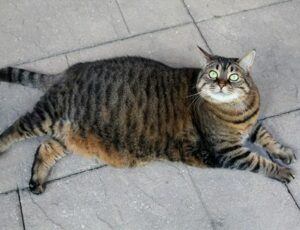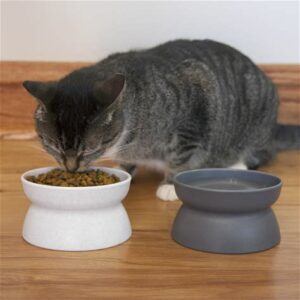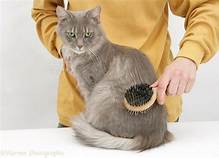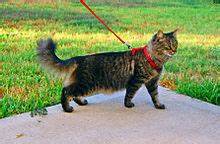Do you think you might have an arthritic cat? Have you looked for ways to help ease his pain? Have you learned some things about the treatment for arthritis in cats?
My 16-year-old cat, Pogo, has arthritis. Since I brought him home from the shelter 2 1/2 years ago, his health has improved considerably, and we have his arthritis under control. I will tell you his story shortly. But first, let’s look at some signs your cat may have arthritis. Then we will discuss the treatments currently available.
Signs Your Cat Could Have Arthritis
Do you see any of these behaviors in your cat?
- Does he sleep more?
- Is he less active? (Does he still roll on his back or stretch as he used to?)
- Does he seem overly anxious or restless?
- Does he seem to be protective of certain parts of his body?
- Has his gait slowed?
- Does he have trouble jumping?
- Does he seem less tolerant of brushing or petting?
- Has he changed his grooming behavior?
- Does he have a limp?
- Is it hard for him to find a comfortable sleeping position?
As cats tend to hide their pain, it may be hard to tell if he has a lot of discomfort.
Watch For Litter Box Changes
Watch to see if he changes the way he’s using the litter box. If he stops using it, the cause might relate to arthritis. If it hurts him to climb in and out, he may decide the floor might prove a better option.
Is He Overweight?
An overweight cat could cause the onset of arthritis. Managing his weight can address the problem

in part. To lose weight, he needs more exercise and less food.
If you need help to work out a healthy diet that will also help kitty reduce, you might consult your vet. As for play, you can get your cat to play with a wand toy or chase a laser light. Maybe you have a puzzle feeder that will keep him active as he retrieves his food.
Supplements Available To Put In Food
Something you might try is a joint supplement. Your vet could suggest oral supplements such as glucosamine and chondroitin sulfate. These come in treats, liquids, and sprinkle powders.
Omega 3 fatty acids, found in fish oils, can help reduce the inflammation caused by arthritis.
Other medications could help, and perhaps your vet has suggestions he finds effective.
Massage Can Prove Helpful
Learn how to massage your cat gently in the areas where he experiences pain. Gently rubbing can work out some of the pain, and you will have the added benefit of bonding closer with your cat.
What About Modifying Your Living Space?
Some small changes you can make in your house that could make things easier for kitty:
1) Build easy access to his favorite spots by using furniture or cat stairs that will lead him there.
2) Make sure to put food bowls someplace that is easy for him to reach.

3) Using a raised food bowl can make it more comfortable for kitty, especially if neck and shoulders are sore.
4) Use low-sided litter boxes and make sure to provide more than one in easy-to-access spots. Make sure the litter box will allow him to turn around inside it without touching the walls, and that there is a low spot where he can enter.
If you are using a tall box, you might want to cut out a lower opening in the front to make it easier for kitty to go in and out.
Ease Of Access To All Necessary Spots
Think about where you place food and water, bed, and toys, all in places that kitty can reach easily. Once you have decided where they need to go, do not change the location, as you could confuse the cat.
If your cat sleeps on your bed, you might install a ramp or steps to help give kitty access. In my house, I have a chair next to the bed. Pogo jumps onto that and then onto the bed.
Help With Grooming

As it becomes harder for the cat to groom himself properly when his arthritis flares, help him out by grooming him regularly.
Just remember to be very gentle, as you want a pleasing experience for kitty.
Also, trim his claws regularly, as this will minimize the pain of his feet. Long nails can make a limp worse, or they may cause his feet to hurt when he walks on them.
Ask your vet or look for online sources that will teach you how to massage an arthritic cat. Such a technique can really help reduce his pain.
Make Sure To Promote Low-Impact Activity
Just as with humans, inactivity can make the problem worse. You can help avoid muscles that

atrophy and shrink from disuse by encouraging low-impact activity.
When playing, don’t expect kitty to jump for a dangling toy. Move it just high enough so a one-paw reach will get it. With chase games, move the toy slowly so the cat can choose a speed of pursuit that he finds comfortable. Leisurely walks together can also help.
Pogo’s Story
When I brought Pogo home from the shelter, he had a number of problems and was obviously arthritic.
First, he needed to get rid of excess weight. Over time, he lost all his extra pounds, which helped a great deal with his mobility.
At first, he walked very slowly. He would not run at all. He had a bad limp. He preferred not to receive a great deal of petting. Actually, I think he liked the attention, but his back must have hurt,

because he didn’t want much stroking. He didn’t want to jump on anything.
One of the reasons he had so much extra weight arose from the fact that he didn’t like his medicated food for urinary tract health, which he got in the shelter. Since some of the cats, including him, could roam freely within their quarters, he would steal food from other cat residents.
He had kidney disease as well, so when I brought him home I had to put him on a renal care diet. He eats twice a day, and receives the quantities of food he needs, and no more.
For His Arthritis, I Used CBD
My method of treatment is CBD oil. If you choose to try this method, make sure to get a CBD oil designed for cats, with no THC content. The THC does not do a cat’s nervous system any good.

Good companies that make such supplements for cats will supply information on the proper dosage. Pogo got his CBD after each of his two meals and once in the wee hours of the morning. He followed this procedure for two years, receiving from six to eight drops of oil with each serving.
At first, he lapped the oil up eagerly, almost as if he knew it did him good. However, he self-regulated. He must have realized the oil made him sleepy, because after two years, he simply refused to take any CBD after his meal, but still took it regularly in the early morning.
I’d started this early-morning treatment because he had started vomiting every morning. After it happened three mornings in a row, I began giving him the oil in the wee hours, as CBD tends to eliminate the vomiting urge. It worked. He rarely vomits now, and it’s usually from a hairball.
How Has The Oil Helped?
Pogo has become a different cat. He walks easily and not slowly and hesitantly. He runs again. He likes to chase a toy on a string. He rarely limps. He likes petting again.
He’s lost all his excess weight. He uses his litter box with no problems. He still does not groom himself as much as he used to, so I make sure to brush him regularly. He purrs when brushed.
If you want to try the CBD treatment, you might ask your vet. Or, just get the proper kind of CBD and read the instructions for dosage carefully. Start with a very small dose at first, and add more if you feel his condition warrants it.
How To Get The Oil In The Cat
Put his drops in his food, if he won’t eat it by itself. At first, I soaked a couple of treats with CBD, until I discovered he’d just lap it up. Lucky me!
Another thing that has helped Pogo: A few months ago, I moved a single bed with a magnetic mattress into the room where he eats. After sleeping with me for two years, every night, he has now abandoned me to sleep on that magnetic bed. I think it must also help to lower his pain and bring on sleep.
As I, too, have arthritis, I have great sympathy for the cat, and will do whatever I can to help him manage this disease. I’m proud of Pogo — he does very well, these days. May you, too, find a working solution to help your kitty.
References I used for this post:
https://thesprucepets.com/effective-treatment-for-arthritis-in-cats-3384622
https://thesprucepets.com/causes-and-signs-of-arthritis-cats-3384621
https://petmd.com/cat/general-health/arthritis-treatment-cats
zoetispetcare.com/blog/article/make-arthritic-cat-comfortable
catwatchnewsletter.com/health/5-things-to-help-the-arthritic-cat/

